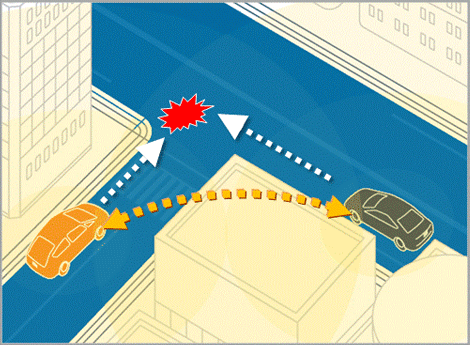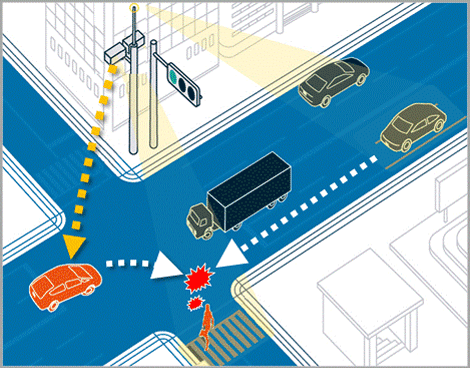
A highway demonstration experiment. (Photo courtesy of Nissan Motor Co., Ltd.).
Simply climb into the driver's seat and give the computer a location, then you will be taken to your destination. The development of such a dream car is progressing in many countries worldwide. Japan, where there are many manufacturers from the world, is not an exception. Many engineers in Japan are enthusiastically researching this.
Equipped with a millimeter-wave radar

An autonomous vehicle during an experiment on a highway. The computer locates highway entrances and exits, switches on the turn indicator when it approaches its destination and heads for the exit. The developer sitting in the driving seat is not touching the steering wheel. © Kyodo News Service.
One of the world's leading car manufacturers aims to launch a computer-operated car by 2020. Currently, research into avoiding obstacles on roads is ongoing, with the use of test courses. Even when rain or snow causes visibility to be poor, millimeter-wave radar, which can accurately measure the distance between the car and objects around it, can locate obstacles 200 meters ahead. The experimental car has four to six cameras attached. Camera images of obstacles located by the millimeter-wave radar are analyzed by a computer which makes judgments on what they are. If the obstacle is a pedestrian, the computer will reduce the car’s speed and pass safely, and if the obstacle is a large stone, the computer will operate the steering wheel to avoid it. The reflected rays of the laser continually observe the surroundings, not only in front of the car but also to the side and rear, for obstacles such as other cars and bicycles.

Millimeter waves or lasers become the “eyes” of the autonomous vehicle.(Photo courtesy of Nissan Motor Co., Ltd.).
Research into prevention of collisions at intersections with poor visibility is also progressing. Communication devices which are connected to the internet are placed in the vicinity of intersections and receive signals from approaching vehicles. By conveying this information to other vehicles in the vicinity of the traffic lights, cars can pass through the intersection safely. Sensors fitted to traffic lights can let nearby vehicles know if pedestrians are crossing, thereby preventing accidents with pedestrians.

The car is notified that another vehicle is approaching via an internet channel. (Photo courtesy of Toyota Motor Corporation).
If wireless devices are fitted to traffic lights they can also let approaching cars know how long it will take for the signal to turn to red. Computer-operated cars will adjust the speed of the car so that they will not stop at the traffic lights. By doing so, traffic will flow smoothly and congestion will be reduced.

A sensor fitted to traffic lights lets the approaching vehicle know of the presence of a pedestrian (Photo courtesy of Toyota Motor Corporation).